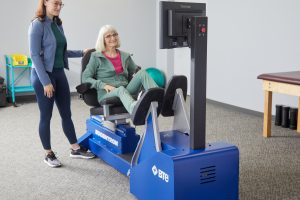-

Pinch strength plays a crucial role in daily tasks, from self-care to sports, yet it often goes unnoticed until weakness sets in. This article explores the importance of pinch strength, effective exercises to improve it, and advanced rehabilitation tools like the PrimusRS that enhance therapy outcomes.
-

Learn how to measure hand grip strength, track progress, and enhance therapy outcomes with personalized grip strength exercises. Enhance injury recovery, build strength, and help patients regain functional abilities with the PrimusRS' advanced grip strength testing and treatment protocols.
-

Eccentric training is transforming Parkinson's disease rehabilitation by addressing motor challenges with groundbreaking results. Discover how high-intensity eccentric resistance training can improve strength, mobility, and quality of life for PD patients. Learn about the latest research and practical strategies for physical and occupational therapists.
-

Explore the world of fun, effective, and evidence-based therapeutic gaming devices like you've never seen before. Discover how engaging exercises promote neuroplasticity and transform your hand therapy practice, featuring Q&A from our recent webinar with ASHT.
-

Learn how to do the Unterberger Test, interpret results, and enhance your balance assessments with data-driven balance assessment devices.
-

Nearly every plan of care will focus on strengthening the injured area, whether knee, ankle, elbow, and every other joint in the body. Shouldn't cervical spine rehabilitation follow suit? Learn how neck strengthening tools can relieve neck pain, improve cervical spine injury recovery, and promote long-term health.
-

A recent study examined the outcomes of an eccentric-focused physical therapy program for post-hip fracture recovery. Participants using BTE's Eccentron showed positive improvements in lean muscle mass, force production, and functional abilities.
-

Balance assessments play a key role in gauging your stroke patient's fall risk, functional abilities, vestibular impairment, proprioception, and more. Read on for a breakdown of five essential balance assessments in stroke rehab: Romberg, Unterberger, Berg Balance Test, timed up and go, and functional reach test.
-

With specialized task simulation tools, occupational rehab clinics can recreate realistic work environments, making the transition back to the job smoother. This involves accurately matching the weight and handle of objects, meeting endurance and repetition requirements, and simulating lifting heights.



